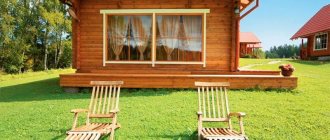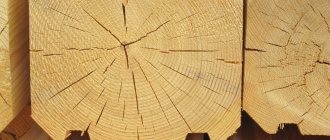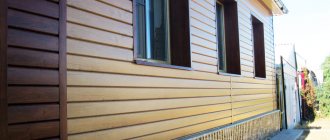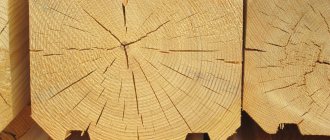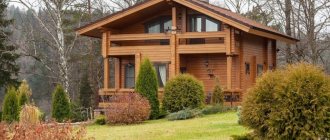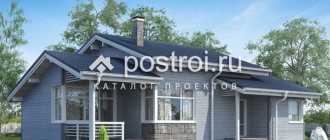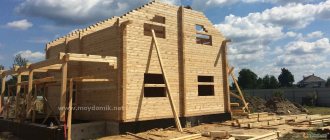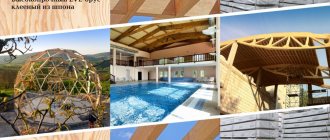The material was prepared with the help of specialists from the Wooden House Construction Association.
The history of log houses goes back several centuries, they have passed all kinds of tests both by time and by people, and have proven their worth, although they also have some specific properties. Structures made of laminated veneer lumber in our country cannot boast of such an impressive track record and, despite their great popularity, are shrouded in a whole set of myths. In this material we will talk about the most common “horror stories” related to glue and the technology itself:
- The technology is “young” - will the lamellas come apart?
- How harmful is glue to health?
- How effective is the glue? Will the timber “come apart” in a few years?
New generation material – laminated veneer lumber
Most people, especially the population of megacities, dream of environmentally friendly housing and better living conditions. Today, traditions going back centuries, coupled with the latest technological processes, make it possible to build wooden houses of excellent quality. Glued laminated timber is the most in demand and popular in the construction of houses, as it is natural, durable and aesthetically pleasing. Such buildings practically do not shrink, have a long service life and are ready for use and finishing immediately after completion of installation work.
Reviews
- Andrey, 25 years old: “I spent a very long time analyzing and comparing the positive and negative aspects of laminated veneer lumber before I built a house from it. But as a result of my reflections, I realized that the number of positive characteristics is greater. Firstly, such material does not shrink or crack, which is very important. You don’t really want to notice in a few years how the appearance of your home has been spoiled. Secondly, laminated timber is not susceptible to deformation. Of the minuses, I would only note the high cost of this material, although it is fully justified by its qualities.”
- Oleg, 38 years old: “I’ll start right away about the shortcomings of the material, since there are few of them. The main disadvantage is the cost. Therefore, not everyone can build a house from laminated timber. As for the advantages, they are obvious: low thermal conductivity, beautiful appearance, ease of assembly, environmental friendliness, no shrinkage.”
- Leonid, 56 years old : “I have been working in the construction industry for a long time and I can say that the best material cannot be found. Of course, not everyone can afford it due to its high cost, but the positive qualities it possesses cannot be counted. I built such a house for myself and have been living in it for 5 years. During this time, no negative changes occurred. What was especially pleasing during the construction period was that there was no external finishing, and therefore there was no need to use expensive finishing materials.”
Here you can read about vibration panels for exterior home decoration.
Glued laminated timber is a unique material that is popular in the construction of houses. Of course, it has its drawbacks, but this does not diminish its demand. Having built a house always means a feeling of comfort and reconnection with nature.
Production Features
The building material we are considering is made this way: logs are radially sawn into boards, which are subsequently well dried (taking into account the type of wood), to approximately 10-12% humidity, and mechanically processed, as a result of which all possible defects are removed. After high-quality drying, the wood undergoes a visual inspection to detect and eliminate areas with dead knots, resin pockets and fungal infections.
Then the boards (otherwise called lamellas) are glued together with special compounds and according to a technology specific to such a material. There can be several of them in the finished timber; the length of the blanks can reach up to 18 meters. Next, the wooden beams are dried, and only after that the laminated veneer lumber is calibrated, that is, it acquires its usual rectangular shape.
Details about types of timber
By profile
According to the profile of the working side, the most common types of laminated laminated wall timber for the home are Finnish (Scandinavian) and comb. The second option has small rectangular teeth both at the bottom and at the top of the beam. When laying, these spikes help create a reliable connection. But keep in mind that if the material is of poor quality, the teeth on the material may not match each other, and then you will have to spend a lot of time on adjustment.
With Scandinavian-type timber, the combs together when profiling create a “tongue-and-groove” type sound, which has a recess in the middle. This profile makes it possible to lay a layer of insulation into an existing recess, and this will be completely invisible from the outside. As a result, a house made of Scandinavian-type timber will be warmer. In addition, it will have to be sealed less, which will speed up the construction process.
By type of design
Glued laminated timber for the internal structure for assembling the walls of a wooden building can be purchased in the following types:
Uninsulated (cheap).- Insulated (a little more expensive).
- Bent, to create curved railings and arches.
The insulated version has a layer of thermal insulation material. If you use this type of material, you will not have to buy an additional layer of insulation for a wooden house. But keep in mind that the standard option - uninsulated - is much cheaper. If the thickness of the timber makes it possible to do without additional insulation, then it will be more profitable to purchase it.
In terms of price, the bent version will cost 70-100% more than an analogue with the same cross-section, but without curvature. But keep in mind that without such material it will be difficult to create curved shapes in the interior of the house. This material is both a decorative timber and a structural material with a high level of strength. You can use it to make stairs, arches and other interior structures with curves.
Glued laminated timber of a load-bearing type can be up to 30 cm in cross-section. Products for making windows have a width and thickness of approximately 8-9 cm, and for doors approximately 12 cm. Wall laminated timber without a layer of insulation in cross-section has dimensions from 10 to 18 cm, and the thickness of the insulation in the case of purchasing a similar material with a layer of thermal insulation is 27 cm.
Advantages of laminated veneer lumber
Like any building material, laminated veneer lumber has advantages and disadvantages. First, let's look at its advantages:
1. Houses made of laminated veneer lumber are easy to install and assemble, and shrinkage and shrinkage are kept to a minimum.
2. The material practically does not deform and does not change its shape.
3. During operation, it does not become cracked. Its surface is flat and smooth, requiring no additional processing or labor-intensive and expensive finishing work.
4. Glued laminated timber has optimal humidity, which prevents rotting and the appearance of fungal microorganisms and harmful bacteria in it.
5. This material can be used to implement very complex projects.
Is glue in timber harmful?
The production technology itself involves several adhesive seams in each beam, so potential consumers are most concerned about the environmental friendliness of the material. The timber is produced using various adhesive systems, but most often it is:
- EPI – emulsion of polymers with isocyanate hardener;
- MMF – melamine-formaldehyde;
- PUR – polyurethane adhesive;
- PVA is a polyvinyl acetate emulsion, prohibited for gluing house-building structures, as it loses strength under static load.
The adhesive systems used in the production of laminated veneer lumber undergo mandatory certification and are environmentally friendly, even if it is MMF. Any glue contains chemicals, but if the glue is of high quality, then all of it polymerizes (converts into a solid substance) when gluing the timber. The content of free formaldehyde in the timber will comply with domestic and European standards - EN 14080 and GOST 33122-14.
Unfortunately, it is neither tactile nor visually possible to check whether the manufacturer uses the high-quality glue stated in the documentation, or saves money and makes do with an uncertified system. Therefore, in addition to domestic SES certificates, the plant must also have a personal certificate of the glue manufacturer. The document will indicate that this particular company uses their glue, and that the staff is trained to work with the system. As with everything, when choosing laminated veneer lumber, the rule “trust, but verify” applies.
Oberon
In order not to worry about the environment in the future, ask the manufacturer for Russian and foreign certificates for the glue used. It is quite easy to check a foreign certificate; it indicates the email addresses of the institutions that issued it. Even if you don’t speak the language, you can easily find information within a day, online translators to help, and find out whether such a certificate was issued.
Any remaining doubts can be resolved by asking for a tour of the enterprise, if this is geographically possible - copy the name off the label and check what the glue is.
Minuses
However, it cannot be said that laminated veneer lumber is distinguished by positive characteristics alone. There are also disadvantages, here are some of them:
1. High price for glued material. Such a house will cost 2 times more than buildings made from non-profiled logs.
2. Due to the fact that the manufacturing technology is quite new, data on the behavior of this material over long periods of time (for example, after 30-50 years) are not yet available, since its properties have not yet been studied.
3. Use of glue in the production process. Despite the fact that the adhesive compositions comply with the standards, in terms of environmental friendliness, laminated veneer lumber will be inferior to ordinary profiled timber or logs, since they completely lack such substances. The use of glue worsens some characteristics; in any case, air exchange and moisture circulation do not occur fully. In addition, the indoor microclimate is also disrupted.
General information
Short description
Glued laminated timber is a structural, high-tech wood material. It is made from several layers of wood lamellas (boards, fragments), which are first folded into bags with the required thickness, and then glued under a press. At the end, the material is ground and profiled on a machine. The lumber is intended for the construction of low-rise cottages and other small buildings on a summer cottage.
It is used to create load-bearing walls, floor joists and roof rafters. You can use it to build not only a house, but also a garage, gazebo and even utility yards. It is also used for the manufacture of furniture, stairs, windows, doors and other carpentry products.
When producing laminated veneer lumber for the construction of private houses in Russian factories, the following types of wood are most often used:
Larch.- Pine.
- Cedar.
- Spruce.
The production of timber involves complex, deep processing of raw materials. They use everything - even the trimmings that remain after sawing the wood, and at this stage of sorting, the lamellas that have received defects are rejected or unsuitable areas are simply cut out of them. Thanks to the unique gluing technology, it is possible to use even small fragments.
In the end, the highest quality lamellas come under the press without damage. Before gluing them together in the form of timber, all lumber goes through a preliminary stage, namely drying in a chamber. The resulting product, after being placed in the log house, no longer warps, since it contains little moisture, which means there is simply nothing to evaporate under the sun. Compared to a profiled log house, laminated veneer lumber is a little stronger and smoother during manufacturing. During operation and storage, it does not warp, and after drying in the chamber, its humidity ranges from 8 to 17%.
We also note that, according to reviews from real owners, shrinkage of the walls of a house made of laminated timber is completely excluded. Over the course of a year, they can settle by a maximum of 1%. Compare - a structure made of solid profiled timber or rounded logs with natural humidity will shrink by 11-15% over the same year. The lumber in question has high structural strength due to the fact that the ends are milled before applying glue to it. The surfaces that are glued take on a serrated profile, which guarantees a very strong connection between the boards when bending.
Varieties
Glued laminated timber according to its purpose is divided into:
- Window and door.
- Wall.
- Supporting (bearing).
The second option is used to make the walls of the house. The first is used to make furniture, windows and doors. The third type of timber is used to create load-bearing supports, staircase and roof frames, interfloor beams, etc. The edges of lumber for walls can be either smooth or with spikes to create a strong connection. The remaining types are made rectangular or square in section without cutouts.
What is the reason for the high price of building materials?
Despite the fact that the desire to live in a house made of natural materials is very great, many are deterred by their cost. Indeed, laminated veneer lumber, the disadvantages of which were discussed a little higher, is more expensive than all conventional analogues made of wood - rounded logs, ordinary timber, etc.
The high cost of such material is undoubtedly influenced by the rather complex process of its production. Production costs, cycles, consumption of wood and resources increase, which cannot but affect the cost.
High-quality laminated veneer lumber, of course, has shortcomings, and all of them lie where there is unfair production, irresponsibility, inattention, negligence when choosing equipment and raw materials, etc. Some people use not very high-quality materials in their work, thereby trying to save money and simplify the manufacturing process. However, the homeowner will soon regret this, as his house will literally begin to fall apart and collapse. On the other hand, real laminated veneer lumber is practically not subject to deformation; it is more durable compared to other lumber. It turns out that the inflated price is completely justified. But the low cost, on the contrary, should alert you.
Comparison with profiled
The first parameter in which it is inferior to the profiled one is strength. The reason is that the second type of material is obtained by cutting the outer part of the wood, which in terms of strength indicators is much larger than the inner part.
It will be interesting to learn from the article about MDF panels that can be used in a wooden house.
As for laminated veneer lumber, additional strength comes to it as a result of manufacturing, when it is glued and pressed. For this reason, it is practically not subject to deformation.
A house made of profiled timber, the pros and cons, as well as other characteristics, can be found in the article.
The next difference is humidity. The production of glued bursa is carried out with a humidity level of 11-14%, due to which it practically does not dry out. As for profiled timber, it is characterized by natural humidity, but 18-20% can be achieved using a drying chamber.
For builders of houses made of timber, it will be interesting to learn here about building a house from cinder blocks and foam blocks.
As a result, the profiled timber has moisture that is distributed along the entire length, which adds strength to the material, resistance to fire and less shrinkage. It is also worth noting that over time, a building made of laminated timber will absorb moisture from the environment. This will bring it closer to the profiled material.
How many cubes are in a 100x100 beam can be found out by reading this article.
The last difference between these materials is cost. The price of a profiled bursa is much lower than that of a glued one. This is due to the peculiarities of wood production. However, it is worth taking into account that a house built from laminated veneer lumber does not need cladding. For this reason, the price of building a house from profiled timber with external finishing can be much more expensive.
If you want to build a house made of dry, chamber-drying profiled timber or not, you can read the article.
The video shows the disadvantages and advantages of laminated veneer lumber:
Is laminated veneer lumber safe?
There are often disagreements about the safety of materials such as laminated veneer lumber for humans and the environment. The reason for this controversy is the use of glue in the manufacturing process.
Here you need to take into account that the substances used in the manufacture of such timber consist of natural-based materials. In some ways, glue can be compared to wood resin, which is more durable and resistant to various influences. But since laminated veneer lumber, the advantages and disadvantages of which we have already examined, consists of several boards glued together, there is no need to talk about good movement of moisture and air. Accordingly, we can draw the following conclusion: it is not as useful as solid wood, but it cannot be called harmful either, since all materials used for its production are necessarily certified.
According to statistics, many ordinary homeowners and construction companies choose laminated veneer lumber. Disadvantages (reviews about the use of this material confirm this), of course, affect some properties of wood, but this is not critical.
Standard or individual project?
At the beginning of any construction, a project is selected. Design allows you to competently plan the space and calculate the cost of work. Construction without a project takes longer and does not guarantee results. At such construction sites, all issues are resolved during the construction of the structure, which is completely ineffective. Before placing an order to create a house project, you need to determine its type. You can choose a standard project or order an individual development with a detailed plan.
- Typical. Standard designs that have most likely already been used in the construction of other buildings. They are completely suitable for work and can be agreed upon by different authorities. Such a project is suitable if the construction budget is limited and the cost of the project is important. You can also choose a standard plan if you don’t have time to wait for a custom plan. If you do not plan to live in the house all year round, then a conventional layout will also suffice. Standard projects have certain disadvantages. For example, they may not be suitable for certain landscapes or specific sizes. Also, the layout of the premises does not always coincide with the wishes of the future owners.
- Individual. By ordering such a layout, you receive guarantees that the architects will take into account any of your requirements. Each step in the development of such a project is discussed with the customer. A specialist creates a functional structure for living all year round. This design method is suitable if nothing in the catalogs with standard projects suits you. Also, an individual plan is relevant for customers who already have a clear idea of their ideal home. It happens that standard buildings (small or non-standard plots of land) cannot be placed on the territory. In this case, individual design will also be required. The disadvantages of this solution include the high price of architects' services. It also takes a lot of time to create such a project.
Varieties
There are different types of this material. Depending on the design and purpose, they can be divided into 2 groups:
1. Building materials for the construction of walls (for this, insulated or ordinary laminated veneer lumber is used).
2. Materials for the construction of individual structures (bent laminated veneer lumber and window beams, floor beams, etc.). The most popular are the Finnish and German types. Scandinavian laminated veneer lumber, the only disadvantage of which is that it requires the use of additional compaction (and in general it is a common type of profile), differs from the rest in the presence of two side tenons and special grooves. Such products are connected with a strong lock, and in the middle there is a place for laying the seal. The German profile is recognized by its comb-shaped connection. It provides maximum density without the use of sealing material.
Difference from usual
If we draw an analogy between these two materials, then there is not much difference between them. The first is the profile shape. In ordinary material it takes the form of a rectangle or square, in glued material it takes the form of a complex geometry. In addition, minor elements play an important role in determining the properties of these lumber.
You can find out which is better than logs or laminated veneer lumber from the article here.
The next difference is the cost. There is a big difference in price between regular and laminated timber. For example, the average cost of ordinary timber per m3 will be 7,000-9,000 rubles, but laminated timber – 18,000-24,000 rubles. Which option is right for you is up to you to decide.
In this article you can learn how to make a wooden floor in a house.
The video shows the advantages of laminated veneer lumber over regular timber:
